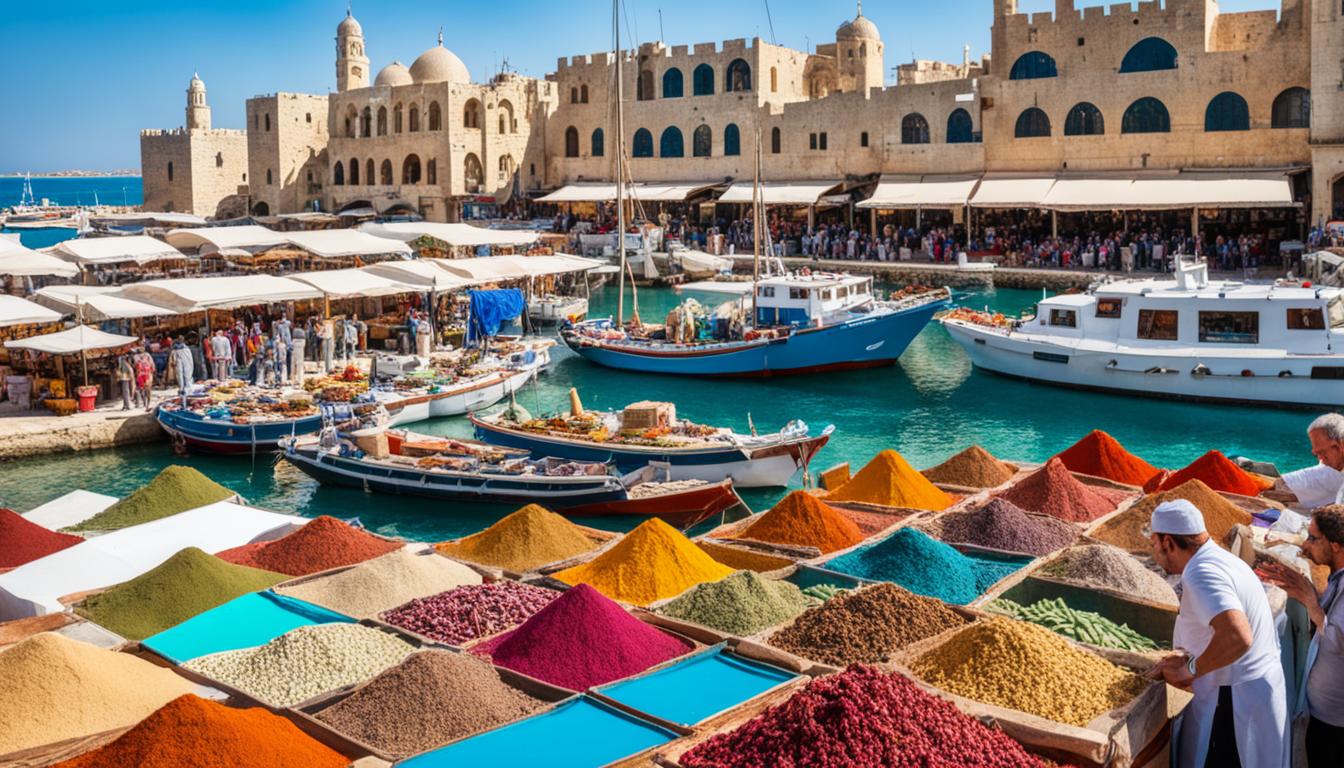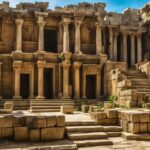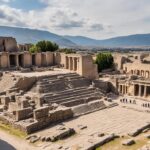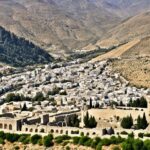Welcome to a fascinating journey through the biblical city of Sidon. In this article, we will delve into the rich history, cultural significance, and biblical references of this ancient Phoenician city. Situated in modern-day Lebanon, Sidon played a pivotal role in biblical narratives, offering a deeper understanding of the biblical context and God’s plan for humanity.
Key Takeaways:
- Sidon holds great historical and spiritual significance in the Bible.
- It was an important Phoenician city, with a rich history and cultural heritage.
- Sidon’s geographical location facilitated trade and cultural exchange.
- Archaeological discoveries in Sidon shed light on its ancient past.
- Sidon’s biblical references highlight theological themes and key events.
The Historical Significance of Sidon
Sidon, with its rich history and diverse cultural heritage, holds immense historical significance. As one of the major cities of the Phoenician civilization, Sidon played a pivotal role in Mediterranean trade and cultural exchange.
The Phoenicians, known for their maritime prowess, established Sidon as a prominent city along the eastern coast of the Mediterranean Sea. Its strategic location allowed it to flourish as a center of power and influence.
With skilled craftsmen and a vibrant cultural life, Sidon became renowned for its exquisite art and craftsmanship. The city’s artisans produced beautiful metalwork, ceramics, and textiles, showcasing the sophistication and creativity of the Sidonian civilization.
“Sidon, with its flourishing trade routes and skilled craftsmen, thrived as a pivotal center of cultural exchange in the ancient world.”
The historical significance of Sidon is further highlighted by its contributions to the development of the Phoenician alphabet. The Phoenicians, including the Sidonians, were among the first to create a phonetic writing system, which had a lasting impact on the world of communication.
Sidon’s Cultural and Economic Contributions
| Contributions | Description |
|---|---|
| Maritime Trade | Sidon’s strategic location made it a thriving maritime trade hub, facilitating the exchange of goods and ideas throughout the Mediterranean region. |
| Craftsmanship | The Sidonian civilization was known for its skilled craftsmen who produced exquisite metalwork, ceramics, and textiles. |
| Phoenician Alphabet | The Phoenicians, including the Sidonians, developed a revolutionary phonetic writing system that influenced the development of alphabets worldwide. |
Sidon’s historical significance extends beyond its economic and cultural contributions. As we delve deeper into the Sidonian civilization, we uncover fascinating insights into its art, architecture, religious practices, and social structures.
Join us in the next section as we explore the geographical location of Sidon and its relevance in biblical narratives.
The Geographical Location of Sidon
Sidon, an ancient city of great historical and spiritual significance, is located in modern-day Lebanon. Situated approximately 25 miles north of Tyre and 48 miles south of Beirut, Sidon rests on the eastern coast of the Mediterranean Sea. In biblical times, Sidon was an integral part of the land of Canaan and was situated within the territory of the tribe of Asher. Its coastal location made it a prosperous hub for trade and cultural exchange with neighboring regions.
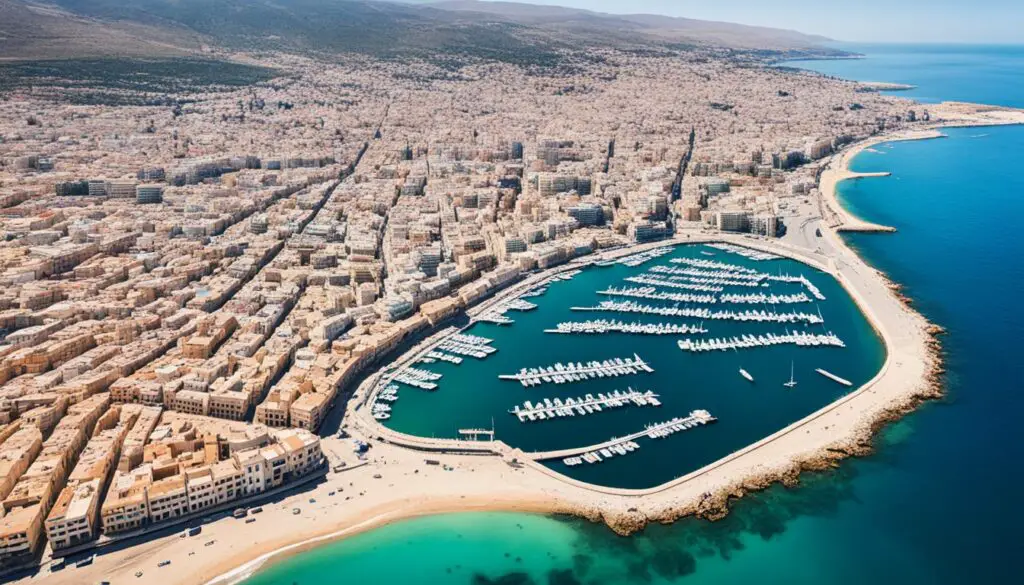
Geographical Details
The strategic placement of Sidon along the Mediterranean Sea made it an ideal center for maritime activities. This location allowed the city to benefit from its proximity to key trade routes, enabling the development of a thriving economy and fostering cultural diversity. Sidon’s coastal location attracted numerous merchants, traders, and travelers, further enhancing its significance as a commercial hub.
Historical Significance
Sidon’s geographical location in the Bible contributes to its historical importance and impact on biblical narratives. The city’s proximity to other significant locations, such as Tyre and Beirut, facilitated interactions between diverse cultures, fostering the exchange of ideas, goods, and religious practices. Sidon’s geographical context enriches our understanding of the city’s historical development, cultural influences, and contributions to the wider Mediterranean region.
Archaeological Discoveries in Sidon
Sidon, the ancient Phoenician city, is a treasure trove of archaeological discoveries that provide invaluable insights into its rich history and cultural significance.
Excavations in Sidon have unearthed remnants of ancient palaces, temples, fortifications, and tombs, painting a vivid picture of the city’s past. These discoveries shed light on various aspects of Sidon’s society, including its art, architecture, religion, and social structures.
One notable find in Sidon is a collection of statues, stelae, pottery, and inscriptions. These artifacts offer fascinating glimpses into the artistic expression and beliefs of the ancient Sidonians.
Artifacts such as statues reveal the skill and craftsmanship of Sidon’s artists, showcasing their attention to detail and mastery of form. The stelae, inscribed with ancient texts, provide valuable information about the rituals, religious practices, and historical events that shaped the city’s culture.
Furthermore, the pottery fragments found in Sidon provide evidence of the city’s flourishing trade networks and artistic traditions. These vessels offer clues to the daily lives of the Sidonians, including their cooking methods, storage practices, and social customs.
By piecing together these archaeological puzzle pieces, researchers and historians can deepen their understanding of Sidon’s past and unravel the mysteries of its ancient civilization.
| Archaeological Discoveries in Sidon | Description |
|---|---|
| Ancient Palaces | Remains of opulent palaces that showcase Sidon’s architectural grandeur. |
| Temples | Sacred sites dedicated to various deities worshipped in ancient Sidon. |
| Fortifications | Protective structures that safeguarded Sidon from external threats. |
| Tombs | Final resting places of Sidon’s elite, revealing burial practices and rituals. |
| Statues and Stelae | Artistic creations that offer insights into Sidon’s artistic style and religious beliefs. |
| Pottery and Inscriptions | Fragments that shed light on Sidon’s trade networks, daily life, and historical events. |
Through ongoing excavations and research in Sidon, the archaeological community continues to uncover new discoveries that deepen our understanding of this remarkable ancient city.
Theological Themes in Sidon
Sidon is mentioned in various passages of the Bible, where it serves as a backdrop for important theological themes. These themes include God’s grace and mercy extending beyond ethnic boundaries, faith and persistence in seeking healing, and the recognition of Jesus as the Messiah. Sidon’s biblical references highlight the inclusiveness of God’s salvation plan and remind believers of the importance of faith and trust in His power.
Key Biblical Events in Sidon
Sidon is associated with several key biblical events. One notable event is Jesus’ interaction with a Canaanite woman in the region of Tyre and Sidon. His compassion and healing of her daughter demonstrate the inclusiveness of His ministry and the importance of faith.
“Then Jesus went thence, and departed into the coasts of Tyre and Sidon. And, behold, a woman of Canaan came out of the same coasts, and cried unto him, saying, Have mercy on me, O Lord, thou son of David; my daughter is grievously vexed with a devil. But he answered her not a word. And his disciples came and besought him, saying, Send her away; for she crieth after us. But he answered and said, I am not sent but unto the lost sheep of the house of Israel. Then came she and worshipped him, saying, Lord, help me. But he answered and said, It is not meet to take the children’s bread, and to cast it to dogs. And she said, Truth, Lord: yet the dogs eat of the crumbs which fall from their masters’ table. Then Jesus answered and said unto her, O woman, great is thy faith: be it unto thee even as thou wilt. And her daughter was made whole from that very hour.”
Matthew 15:21-28 (KJV)
Additionally, the widow of Zarephath, who was from Sidon, experienced a miracle performed by the prophet Elijah.
“And the word of the Lord came unto him, saying, Arise, get thee to Zarephath, which belongeth to Zidon, and dwell there: behold, I have commanded a widow woman there to sustain thee. So he arose and went to Zarephath. And when he came to the gate of the city, behold, the widow woman was there gathering of sticks: and he called to her, and said, Fetch me, I pray thee, a little water in a vessel, that I may drink. And as she was going to fetch it, he called to her, and said, Bring me, I pray thee, a morsel of bread in thine hand. And she said, As the Lord thy God liveth, I have not a cake, but an handful of meal in a barrel, and a little oil in a cruse: and, behold, I am gathering two sticks, that I may go in and dress it for me and my son, that we may eat it, and die. And Elijah said unto her, Fear not; go and do as thou hast said: but make me thereof a little cake first, and bring it unto me, and after make for thee and for thy son. For thus saith the Lord God of Israel, The barrel of meal shall not waste, neither shall the cruse of oil fail, until the day that the Lord sendeth rain upon the earth. And she went and did according to the saying of Elijah: and she, and he, and her house, did eat many days. And the barrel of meal wasted not, neither did the cruse of oil fail, according to the word of the Lord, which he spake by Elijah.”
1 Kings 17:8-16 (KJV)
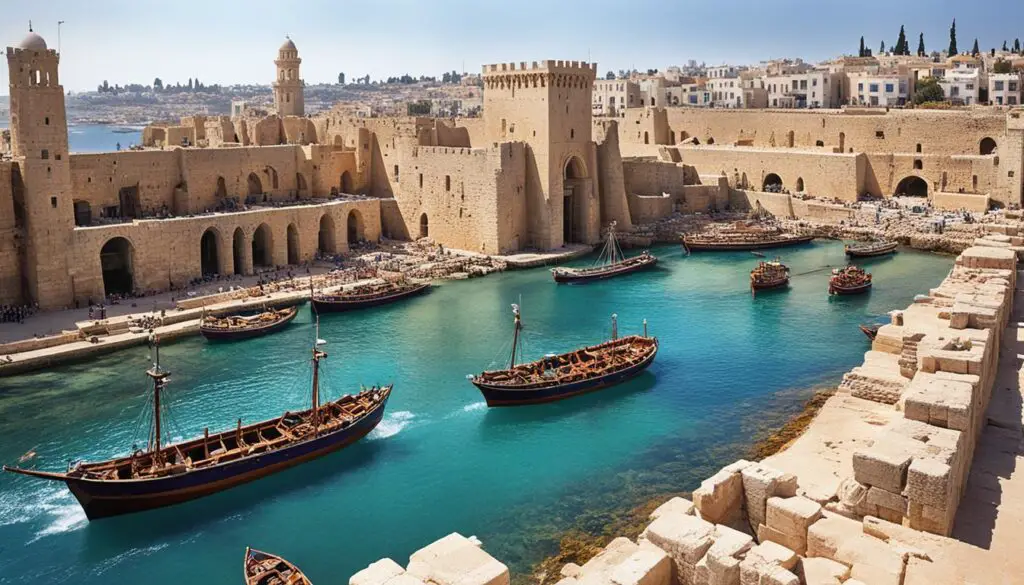
Cultural and Religious Practices in Sidon
Sidon, an ancient city, had its own unique cultural and religious practices that shaped its identity. The city’s religious beliefs were diverse, with an emphasis on the worship of various deities. One prominent deity revered in Sidon was Eshmun, the god of healing.

The significance of healing rituals and beliefs can be seen in the archaeological remains of the Eshmun temple in Sidon. These remnants provide a glimpse into the religious practices surrounding the god of healing. Additionally, statues depicting the healing of children highlight the importance placed on healing and well-being in Sidon’s religious traditions.
Sidon was also known for its skilled craftsmen who produced exquisite metalwork, ceramics, and textiles. These artistic creations reflected the city’s cultural heritage and contributed to its vibrant cultural scene. Sidon’s craftsmanship and artistic endeavors were admired and sought after, further enhancing the city’s cultural significance.
Prophetic and Eschatological Significance of Sidon
Within the pages of the Bible, Sidon holds great importance in prophetic and eschatological contexts. Prophecies specifically mention Sidon as a city that will face judgment for its sins and unfaithfulness. These prophecies serve as admonitions and reminders of God’s justice, showcasing His righteousness and holiness.
In addition to its judgment, Sidon’s mention in biblical prophecy also points to its role in the end times and the restoration of God’s people. As the fulfillment of God’s plan unfolds, Sidon plays a significant part in the ultimate destiny of humanity. It serves as a reminder of God’s sovereignty and His ultimate purposes for His creation.
Sidon’s prophetic and eschatological significance underscores the profound nature of biblical prophecy and its relevance in understanding God’s plan for the world. It serves as a call to repentance and a warning against unfaithfulness, emphasizing the importance of a deepened relationship with God.
In the words of the prophet Jeremiah:
“And the coast shall be for the remnant of the house of Judah; they shall feed thereupon: in the houses of Ashkelon shall they lie down in the evening: for the LORD their God shall visit them, and turn away their captivity” (Jeremiah 47:5).
As these prophetic words reveal, Sidon’s role goes beyond its historical and geographical significance. It points to a bigger narrative that encompasses the faithfulness and redemption of God’s people.
Key Points:
- Sidon’s prophetic significance lies in its mention as a city to be judged for its sins and unfaithfulness.
- These prophecies serve as reminders of God’s justice and righteousness.
- Sidon’s mention in biblical prophecy also points to its role in the end times and the restoration of God’s people.
- Understanding Sidon’s prophetic and eschatological significance sheds light on God’s ultimate plan for humanity.
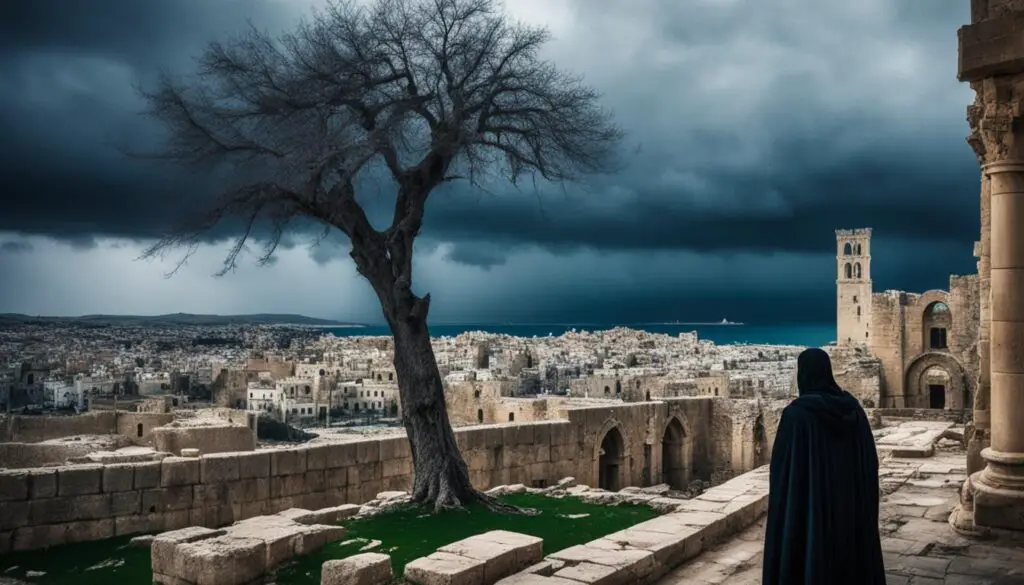
Comparison of Sidon’s Prophetic References
| Prophecy | Reference | Main Theme |
|---|---|---|
| Prophecy 1 | Jeremiah 47:4-5 | Judgment and Restoration |
| Prophecy 2 | Ezekiel 28:22-23 | God’s Judgment on Sidon |
| Prophecy 3 | Joel 3:4-8 | Sidon’s Involvement in International Conflict |
Conclusion
Exploring Sidon in the Bible reveals its profound historical and spiritual significance. This ancient Phoenician city played a crucial role in biblical narratives, containing key events, cultural practices, and theological themes. Sidon’s archaeological discoveries provide valuable insights into its rich history and cultural heritage. Prophetic and eschatological references add a deeper layer of significance, highlighting the city’s role in God’s plan. By understanding Sidon’s biblical references, we gain a greater appreciation for its place in the biblical narrative and its enduring relevance.
FAQ
What is the historical significance of Sidon?
Sidon has a rich history, being one of the major cities of the Phoenician civilization and a hub for trade and cultural exchange in the ancient world.
Where is Sidon located in the Bible?
Sidon is located in modern-day Lebanon, approximately 25 miles north of Tyre and 48 miles south of Beirut, on the eastern coast of the Mediterranean Sea.
What archaeological discoveries have been made in Sidon?
Excavations have uncovered ancient palaces, temples, fortifications, tombs, statues, stelae, pottery, and inscriptions that provide insights into Sidon’s art, architecture, religion, and social structures.
What are the theological themes in Sidon?
Sidon’s biblical references highlight themes such as God’s grace and mercy extending beyond ethnic boundaries, faith and persistence in seeking healing, and the recognition of Jesus as the Messiah.
What are some key biblical events associated with Sidon?
One notable event is Jesus’ interaction with a Canaanite woman in the region of Tyre and Sidon, where He displayed compassion and healing. Another event is the miracle performed by the prophet Elijah for the widow of Zarephath, who was from Sidon.
What were the cultural and religious practices in Sidon?
Sidon worshiped various deities, including Eshmun, the god of healing. The city also had skilled craftsmen who produced metalwork, ceramics, and textiles.
What is the prophetic and eschatological significance of Sidon?
Sidon is mentioned in biblical prophecies as a city to be judged for its sins and unfaithfulness. It also alludes to its role in the end times and the restoration of God’s people.
What is the significance of Sidon in the Bible?
Exploring Sidon in the Bible reveals its profound historical and spiritual significance, showcasing its role in biblical narratives, key events, cultural practices, and theological themes.
